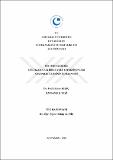| dc.contributor.advisor | Almiş, Habip | |
| dc.contributor.author | Kiliç, Fedli Emre | |
| dc.date.accessioned | 2021-04-09T12:05:04Z | |
| dc.date.available | 2021-04-09T12:05:04Z | |
| dc.date.submitted | 2018 | |
| dc.date.issued | 2018-11-14 | |
| dc.identifier.uri | https://acikbilim.yok.gov.tr/handle/20.500.12812/514681 | |
| dc.description.abstract | Amaç: Çocukluk ve adölesan döneminde en sık görülen enfeksiyonlar, üst solunum yolu enfeksiyonları olup bunu idrar yolu enfeksiyonları takip etmektedir. Diş çürükleri; bakterilerin ağız içerisinde çoğalarak diş ve diş etlerine yerleşmesi ve zaman içerisinde diyet ve konak faktörleri ile etkileşime girmesi sonucu oluşan multifaktöriyel ve enfeksiyöz bir hastalıktır. Çalışmamızda ise diş çürükleri ile idrar yolu enfeksiyonları arasında bir ilişki olup olmadığınınaraştırılması amaçlanmıştır.Gereç ve yöntem: Çalışmamıza Ocak 2017 ile Haziran 2017 tarihleri arasında Adıyaman Üniversitesi Tıp Fakültesi Çocuk Sağlığı ve Hastalıkları acil servisine, polikliniklerine başvuran ve çocuk servisinde yatarken idrar yolu enfeksiyonu tanısı alan, yaşları 5-17 yıl arasında değişen 141 olgu dâhil edildi. Olgular diş çürüğü ve idrar yolu enfeksiyonu tipine göre 4 gruba ayrıldı. Olguların yaşları, cinsiyetleri, diş fırçalama alışkanlığı, hematolojik, biyokimyasal, serolojik testleri, tam idrar tahlili, idrar kültürü, kan kültürü, üriner sistem ultrasonografi parametreleri ve çürük diş sayıları ayrı ayrı kaydedildi. Veriler, SPSS (Statistical Package For Social Sciences) 22.0 programı (SPSS Inc., Chicago, IL, United States) kullanılarak analiz edildi. Verilerin karşılaştırılmasında Student t testi, ki-kare, Mann-Whitney U, ANOVA, one-way varyans analizi ve post-hoc testleri kullanıldı.Bulgular: Dört grup (diş çürüğü olup sistit olan olgular, diş çürüğü olup piyelonefrit olan olgular, diş çürüğü olmayan sistiti olan olgular, diş çürüğü olmayan piyelonefriti olan olgular) kıyaslandığında gruplar arasında diş çürüğü sayısı açısından anlamlı fark bulunmadı. Sistit ve piyelonefrit grupları kıyaslandığında piyelonefrit olan grupta diş çürüğü sayısı anlamlı derecede yüksek saptandı. Tüm gruplarda en sık etken Escherichia coli saptandı. Diş çürüğü olup piyelonefriti olan grupta WBC, CRP, ESH gibi pozitif akut faz reaktanları yüksek, RBC, Hct, albümin, amilaz, kalsiyum, klor, demir ve fosfor düzeyleri ise düşük saptandı. Gruplar arasında Hgb, MCV, PLT, MPV, glikoz, üre, kreatinin, ürik asit, AST, ALT, ALP, LDH, GGT, sodyum, potasyum açısından anlamlı fark saptanmadı.Sonuç: Bu çalışmada; piyelonefrit ile diş çürüğü sayısı arasında pozitif bir ilişki olduğu saptandı.Anahtar sözcükler: Çocuk, Diş çürüğü, İdrar yolu enfeksiyonu. | |
| dc.description.abstract | Objectives: The most common infections during childhood and adolescence are upper respiratory tract infections, followed by urinary tract infections. Tooth decay is a multifactorial and infectious disease that occurs when bacteria multiply in the mouth and settle in the teeth and gums and gradually interact with diet and host factors. The purpose of our study was to investigate whether there is any relationship between dental caries and urinary tract infections.Materials and methods: One hundred forty-one patients aged 5-17 years admitted to the Adıyaman University Medical Faculty Child Health and Diseases Emergency Department, outpatient clinics and diagnosed with urinary tract infection during pediatric ward hospitalization between January and June, 2017, were included in the study. The cases were divided into four groups depending on type of dental decay and urinary tract infection. Age, sex, tooth brushing habits, hematological, biochemical and serological tests, complete urine analysis, urine culture, blood culture, urinary system ultrasonography parameters and numbers of decayed teeth were recorded. Data were analyzed on Statistical Package For Social Sciences (SPSS) 22.0 software (SPSS Inc., Chicago, IL, USA). Student's t test, the chi-square test, Mann-Whitney U test, ANOVA, one-way analysis of variance and post hoc tests were used to compare data.Results: There was no significant difference in numbers of decayed teeth among the four groups (cystitis with tooth decay, pyelonephritis with tooth decay, cystitis without tooth decay and pyelonephritis without tooth decay cases). Numbers of decayed teeth were signifantly higher in the pyelonephritis group compared to the cystitis and pyelonephritis groups. Escherichia coli was the most common causative agent in all groups. RBC, Hct, albumin, amylase, calcium, chlorine, iron and phosphorus levels were low while positive acute phase reactors such as WBC, CRP and ESR values were high in the pyelonephritis with tooth decay group. There was no significant difference between the groups in terms of Hgb, MCV, PLT, MPV, glucose, urea, creatinine, uric acid, AST, ALT, ALP, LDH, GGT, sodium and potassium values.Conclusion: Positive correlation was determined between pyelonephritis and numbers of decayed teeth.Key words: Child, Tooth decay, Urinary tract infection. | en_US |
| dc.language | Turkish | |
| dc.language.iso | tr | |
| dc.rights | info:eu-repo/semantics/openAccess | |
| dc.rights | Attribution 4.0 United States | tr_TR |
| dc.rights.uri | https://creativecommons.org/licenses/by/4.0/ | |
| dc.subject | Çocuk Sağlığı ve Hastalıkları | tr_TR |
| dc.subject | Child Health and Diseases | en_US |
| dc.title | Diş çürükleri ile çocukluk çağı idrar yolu enfeksiyonları arasındaki ilişkinin irdelenmesi | |
| dc.title.alternative | İnvestigation of the relationship between dental caries and childhood urinary tract infections | |
| dc.type | doctoralThesis | |
| dc.date.updated | 2018-11-14 | |
| dc.contributor.department | Çocuk Sağlığı ve Hastalıkları Ana Bilim Dalı | |
| dc.subject.ytm | Dental caries | |
| dc.subject.ytm | Children | |
| dc.subject.ytm | Urinary tract | |
| dc.subject.ytm | Urinary tract infections | |
| dc.subject.ytm | Cystitis | |
| dc.subject.ytm | Pyelonephritis | |
| dc.identifier.yokid | 10188809 | |
| dc.publisher.institute | Tıp Fakültesi | |
| dc.publisher.university | ADIYAMAN ÜNİVERSİTESİ | |
| dc.type.sub | medicineThesis | |
| dc.identifier.thesisid | 496894 | |
| dc.description.pages | 81 | |
| dc.publisher.discipline | Diğer | |


